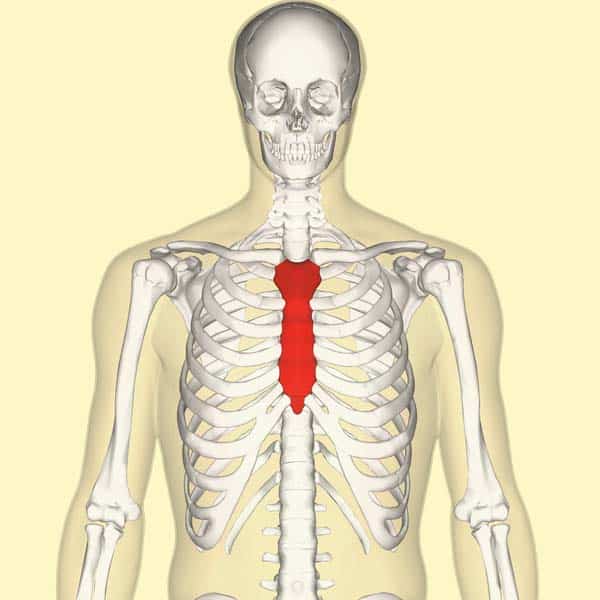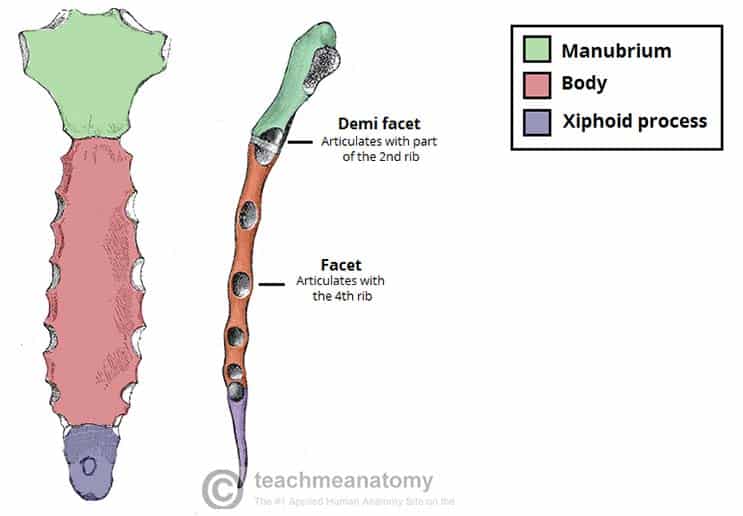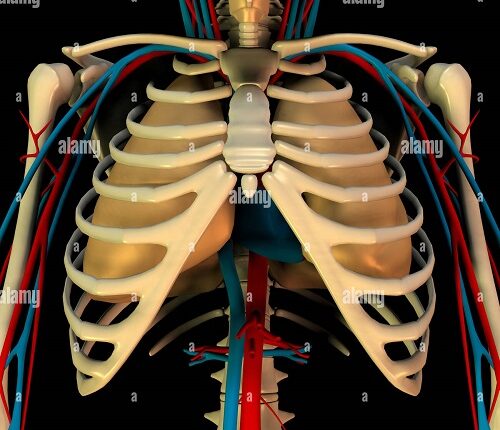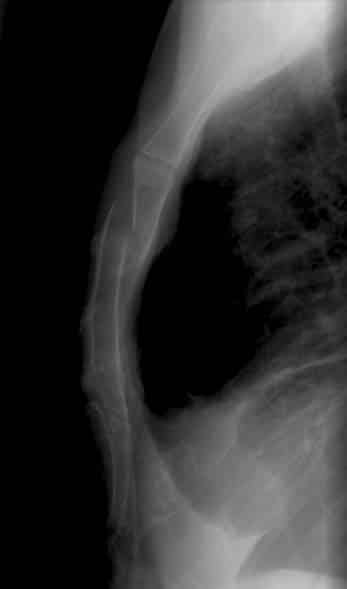The Sternum
The sternum (or breastbone) is a flat bone located at the anterior aspect of the thorax. It lies in the midline of the chest and has a ‘T’ shape.
As part of the bony thoracic wall, the sternum helps protect the internal thoracic viscera – such as the heart, lungs, and esophagus.
In this article, we shall look at the osteology of the sternum – its constituent parts, articulations, and clinical correlations.

Fig 1 – Anatomical position of the sternum in the body thorax.
Parts of the Sternum
The sternum can be divided into three parts; the manubrium, body, and xiphoid process. In children, these elements are joined by cartilage. The cartilage ossifies to the bone during adulthood.
Manubrium
The manubrium is the most superior portion of the sternum. It is trapezoid in shape.
The superior aspect of the manubrium is concave, producing a depression known as the jugular notch – this is visible underneath the skin. On either side of the jugular notch, there is a large fossa lined with cartilage. These fossae articulate with the medial ends of the clavicles, forming the sternoclavicular joints.
On the lateral edges of the manubrium, there is a facet (cartilage-lined depression in the bone), for articulation with the costal cartilage of the 1st rib, and a Demifacet (half-facet) for articulation with part of the costal cartilage of the 2nd rib.
Inferiorly, the manubrium articulates with the body of the sternum, forming the sternal angle. This can be felt as a transverse ridge of bone on the anterior aspect of the sternum. The sternal angle is commonly used as an aid to counting ribs, as it marks the level of the 2nd costal cartilage.
Body
The body is flat and elongated – the largest part of the sternum. It articulates with the manubrium superiorly (Manubriosternal joint) and the xiphoid process inferiorly (xiphisternal joint).
The lateral edges of the body are marked by numerous articular facets (cartilage-lined depressions in the bone). These articular facets articulate with the costal cartilages of ribs 3-6. There are smaller facets for articulation with parts of the second and seventh ribs – known as Demifacets.
Xiphoid Process
The xiphoid process is the inferior and smallest part of the sternum. It is variable in shape and size, with its tip located at the level of the T10 vertebrae. The xiphoid process is largely cartilaginous in structure and completely ossifies late in life – around the age of 40.
In some individuals, the xiphoid process articulates with part of the costal cartilage of the seventh rib.

Fig 2 – The articulations and parts of the sternum.
Clinical Relevance: Fractures of the Sternum
Sternal fractures are associated with severe blunt trauma to the chest, such as in a vehicular accident. They are relatively uncommon.
Typically, the sternum’s will break into several pieces – this type of fracture is classified as a comminuted fracture. The most common site of fracture is the Manubriosternal joint – where the manubrium meets the body of the sternum. Despite the degree of damage to the sternum, the fragments are not usually displaced due to the attachment of the pectoralis muscles.
Sternal fractures have a high mortality rate (25-45%). This is not due to the fracture itself, but usually as a result of heart and lung injuries, which are likely to occur simultaneously with the primary trauma. Because of this, it is crucial to check patients with sternal fractures for visceral injury. X-ray, CT, and ultrasound are common investigations.
The article was originally published here.



Comments are closed.